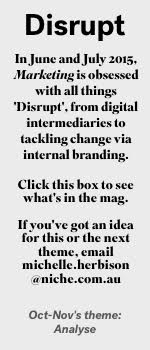Disrupt yourself: What marketers and new parents know about disruption
Share

Disruption is like a toddler: just when you think you’ve got a handle on things, a whole new thing happens that turns your world (or sleeping patterns) upside down, writes Karl Treacher.
 While the toddler analogy may only make sense to new parents, it works on many levels. You see babies, on the whole, are ‘difficult’. Not only because you have to keep them alive (all the time, and for an eternity), but also because they blindside you regularly, and normally just after you’ve finally developed some confidence in their routine or behaviour. This is very disruptive and, furthermore, the disruption itself becomes more sophisticated every time. So thinking that you know something because of the way it behaved in the past is the work of the new parent… and an unskilled marketer.
While the toddler analogy may only make sense to new parents, it works on many levels. You see babies, on the whole, are ‘difficult’. Not only because you have to keep them alive (all the time, and for an eternity), but also because they blindside you regularly, and normally just after you’ve finally developed some confidence in their routine or behaviour. This is very disruptive and, furthermore, the disruption itself becomes more sophisticated every time. So thinking that you know something because of the way it behaved in the past is the work of the new parent… and an unskilled marketer.
There was once a time when we all ordered ‘a coffee’. If you ask a waiter these days, “One coffee please,” you’d be indicating to all around that you don’t get out much.
The café industry has been disrupted by artisanal sourdough, single-origin coffee beans and product diversity.
At least, that’s how I’d describe it if I were a Silicon Valley fan boy, Mad Man or a marketer confused by the industry’s latest buzzword. For everyone else, there are a couple of words to describe what happened to cafés: evolution, change, beards… It’s mostly beards.
Like the hundred buzzwords before it and the hundreds to come after, the popularity of the word ‘disruption’ has risen out of an important truth. That truth is quickly sidelined by the snake oil salesmen who want to stretch, bend and warp the word to capitalise on anything that can be sold under its banner. But remember, disruption is not innovation or just change.
The origins of the concept as we know it go back 20 years to a 1995 Harvard Business Review article called ‘Disruptive Technologies: Catching the Wave’ (and also to Karl Marx, who germinated the idea of creative destruction, albeit not in the positive light many see it in today). Written by Clayton Christensen, this article was the seed for the book The Innovator’s Dilemma: When New Technologies Cause Great Firms to Fail. When smart marketers talk about disruption today, they’re usually talking about Christensen’s definitions or disintermediation.
What is disruption?
Clayton Christensen’s disruption definitions:
- New-market disruption: a product (or service) that addresses a market that could not previously be served.
- Low-end disruption: simpler, cheaper or more convenient product than the existing one.
- In Christensen’s own words, “It’s not a breakthrough innovation!”
Disintermediation:
- Removal of intermediaries, a.k.a. cutting out the middleman, such as the distributor, wholesaler, broker or agent. This is most commonly confused with disruption. See: disruptors Amazon, Netflix and iTunes, and the disrupted travel agents, newspapers and record stores.
When other people talk about disruption, they’re usually confusing it with innovation. The reason for this confusion is actually the elephant in the room: innovation, and even disintermediation, are more palatable to businesses, business leaders and shareholders than disruption. Why? Because it’s precisely the stable structure and good governance of a well-run business servicing its most profitable customers that leaves the door open to Christensen’s disruption. The innovator’s dilemma is this: when the right technology comes along, doing the right thing is the wrong thing because competitors will arise to offer cheaper, inferior alternatives to your product to a market you aren’t servicing. They will then mature to compete with you and potentially even eclipse your segment to own an even more profitable segment. Their dilemma? The same thing can and will happen to them. The clearest and most common goal example is General Motors and Ford as those with the dilemma, and Toyota as the disruptor.
Christensen writes in The Innovator’s Dilemma: “Generally, disruptive innovations were technologically straightforward, consisting of off-the-shelf components put together in a product architecture that was often simpler than prior approaches. They offered less of what customers in established markets wanted and so could rarely be initially employed there. They offered a different package of attributes valued only in emerging markets remote from, and unimportant to, the mainstream.”
Failing forward
In order to fight disruption, organisations must be experimenting with technologies that could open up entry points to their markets for future competitors. They need a culture that embraces experimentation, which must also embrace the most common outcome of experimenting: failing. Sadly, very few do.
In The Economist’s ‘The Rise of the Marketer: Driving Engagement, Experience and Revenue’, Mayur Gupta, global head of marketing technology and innovation at Kimberly-Clark, warns the pace of technological development is increasing. “You can look at future disruption as a multiple of what happened in the past. Disruption in the last five years might show you what will happen in the next three. Disruption accelerates exponentially,” he writes. This means brands will need exponentially more ‘failures’ to successfully defend against disruption.
The same report finds that 81% of marketers agree the structure and design of their marketing organisation needs to change in order to meet the needs of their businesses over the next three to five years. But restructure and redesign need to be about fostering an experimental culture, and broadly marketers aren’t moving that way.
A CEB survey found lukewarm acceptance of failure among Fortune 1000 marketers. When asked whether, “My team accepts that some experiments must fail in order for us to learn from them,” they heard the following: four percent disagree or strongly disagree, nine percent somewhat agree, eight percent neither agree nor disagree, while 28 percent only somewhat agreed.
The opportunity for marketing leaders is to foster this culture of experimentation and failure. What’s incentivised happens. Reward experimentation and learning-from-failure. Or your disruptors will leave… and return with your customers as their customers. Remember: “If the result confirms the hypotheses, you’ve made a discovery. If the result is contrary to the hypotheses, you’ve made a discovery,” according to Enrico Fermi, physicist and Nobel Prize-winner.
Defending against disruption
Clayton Christensen again: “Data is only available about the past. And when we teach people that they should be data-driven and fact-based and analytical as they look into the future, in many ways we have condemned them to take action when the game is over.
The only way you can look into the future where there’s no data is [to] have a good theory… And so, by teaching managers to look through the lens of a theory into the future, you can actually see the future very clearly.”
We’ve defined that breakthrough innovation won’t fight disruption. What will? Fighting fire with fire. CEOs can load disruption’s silver bullet: dominant brands and businesses can seed their own disruptive unit. However, this unit must have a completely different set of success criteria and a different corporate structure – much closer to a VC (venture capital)-backed start-up than the mature business they are born from.
These disruptive units should be headquartered at a different location and, in general, grow and manage their own brand. They’re looking to serve a market you don’t, at prices you wouldn’t, with means you may deliberately avoid because of your current supply chain, serving a product that’s necessarily simpler, cheaper or more convenient to use or access than yours. They’re your competitor. And you should be busy trying to create the better, more innovative, higher-margin version.
Sorry, it wouldn’t be disruptive if it were also easily combatted.















